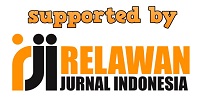INVENTARISASI TUMBUHAN PAKAN LEBAH MADU HUTAN DI DESA UJUNG JAYA KAWASAN TAMAN NASIONAL UJUNG KULON
Abstract
Objective of this research was to identify plant potential as woof source of forest honeybee so woof that produce honey quality and quantity from forest honey bee is available and to identify participation of people around Ujung Kulon national park in guarding and conserving woof source plant for forest honeybee. It was survey research with quantitative method combined with qualitative method. It was conducted by taken sample of one population, to collect data. Information was analyzed qualitatively to obtain clear description on research result. To answers potential of woof plant for forest honeybee it used vegetation analysis and to measure people participation in Ujung Jaya village around Ujung Kulon national park in guarding and conserving plant of woof source for forest honeybee it used quantitative descriptive analysis it used non parametric statistic of Spearman rank correlation. The result indicate that it has been identified in field nine plant species as woof source of forest honeybee in the research site either cultivated or non cultivated by people in the area. Plants as woof source are Salam, Sigeung, Samangan, Kawai, Kijahe, Kiganik, Padipadi, Lame and Tongtolok. Based on spearman rank correlation test, participation level of people around Ujung Kulon national park in guarding and conserving woof source plant for forest honeybee correlate to respondent income with coefficient of 0.267*. The correlation score indicated strong association with
people participation or has significant effect. Meanwhile, age and education level
indicated weak association or no significant effect.
Keywords
Full Text:
PDFReferences
Balai Taman Nasional Ujung Kulon.
Pemantapan Zonasi
Taman Nasional Ujung
Kulon. Laporan Akhir.
Kementerian Kehutanan
Direktorat Jenderal
Perlindungan Hutan dan
Konservasi Alam Balai
Taman Nasional Ujung
Kulon. Pandeglang Banten.
Endraswara, S. 2006. Metode, Teori,
Teknik Penelitian
Kebudayaan. Ideologi,
Epistemologi dan Aplikasi.
Pustaka Widyatama. Jakarta.
Erminawati. 2012. Keajaiban Madu.
Tirtamedia. Tangerang Selatan.
Fachrul, M.F. 2006. Metode Sampling
Bioekologi. Bumi Aksara.
Jakarta.
Kusumosuwidho, S. 2004. Dasar-
Dasar Demografi. Lembaga
Penerbitan Fakultas Ekonomi
Universitas Indonesia.
Jakarta.
Muis, H. 2007. Pengembangan
Partisipasi Masyarakat dalam
Gerakan Rehabilitasi Hutan
dan Lahan: Kasus di
Kelurahan Layana
Kecamatan Palu Timur dan
Kelurahan Lambara
Kecamatan Palu Utara
Kotamadya Palu, Sulawesi
Tengah. Tesis Program
Pascasarjana, Institut
Pertanian Bogor. Bogor.
Mahani. 2011. Keajaiban Propolis
Trigona. Pustaka Bunda. Jakarta.
Odum, E.P. 1971. Fundamental of
Ecology 3nd
Edition. Toppan
Co. Ltd. Japan.
Pius, A. Pratanto. 1994. Kamus Ilmiah
Populer. Arkola. Surabaya
Sitorus, M. 2000. Berkenalan dengan
Sosiologi I. Erlangga, Jakarta.
Sulistyorini, C.A. 2006. Inventarisasi
Tanaman Pakan Lebah Madu
Apis Cerana Ferb di
Perkebunan Teh Gunung Mas
Bogor. Tesis Institut
Pertanian Bogor. Bogor.
Sustri. 2010. Analisis Kimia
Kandungan Nutrisi Pakan
Lebah Madu Hutan. Laporan
Penelitian Hibah Bersaing.
Universitas Tadulako. Palu.
DOI: http://dx.doi.org/10.33512/j.agrtek.v6i2.207
Refbacks
- » website
Copyright (c) 2015 Jurnal Agroekoteknologi
INDEXED BY:
View My Stats

This work is licensed under a Creative Commons Attribution 4.0 International License.










